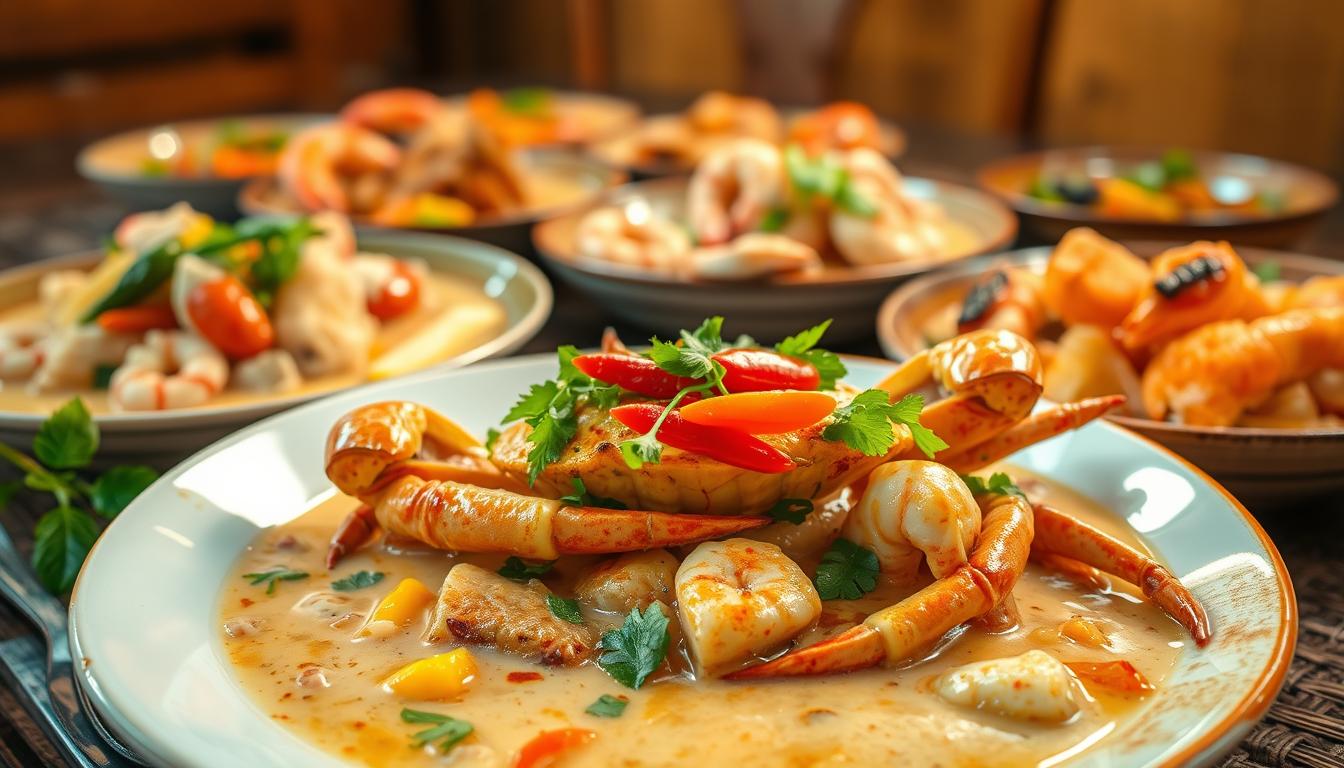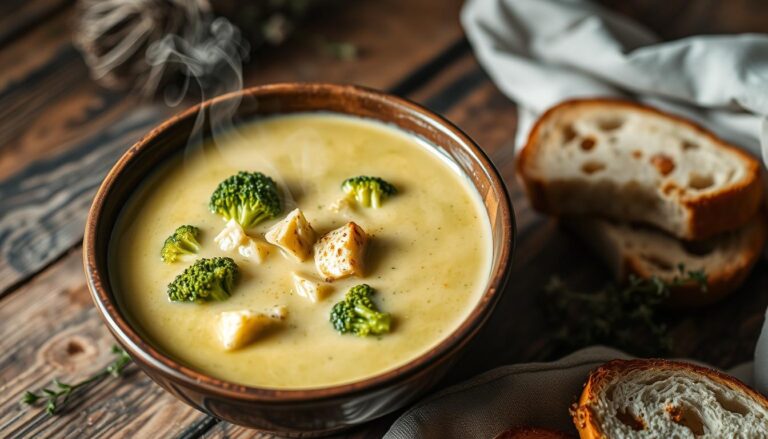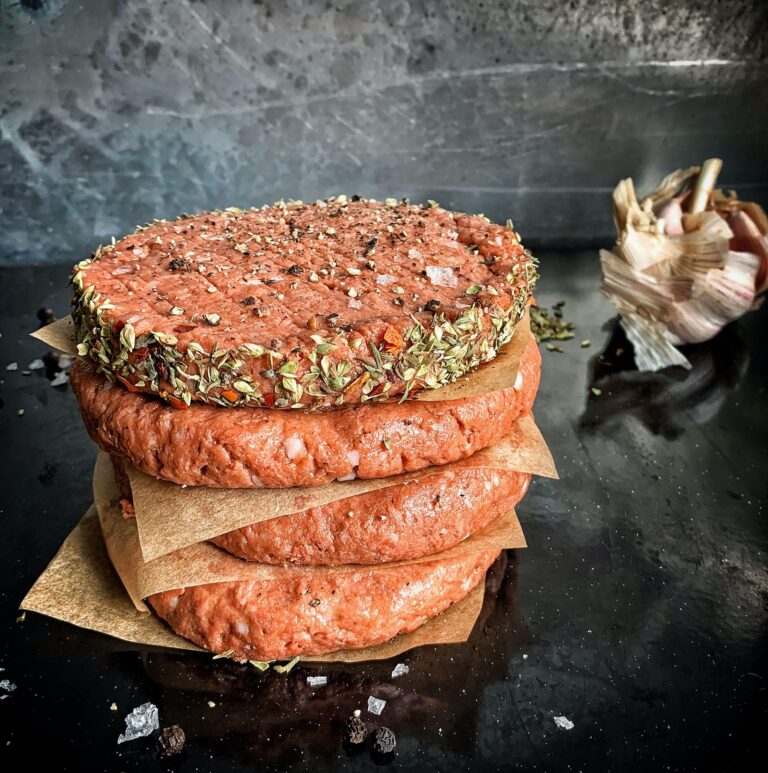Ginataang Alimasag (Crabs in Coconut Milk)
Explore the rich flavors of the Philippines with Ginataang Alimasag. It’s a traditional dish that shows the country’s love for seafood and coconut milk.
This dish is a testament to the simplicity and richness of Filipino cuisine. Fresh crabs are cooked in a creamy coconut sauce. This results in a flavorful and aromatic meal.
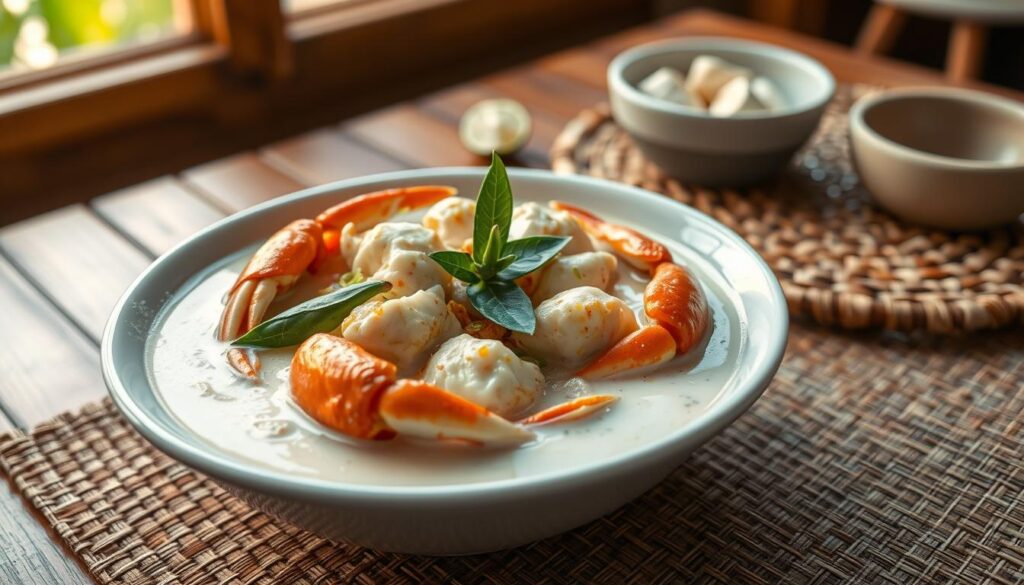
Ginataang Alimasag is more than just a meal. It’s an experience that brings people together. It celebrates the rich culinary heritage of the Philippines.
Key Takeaways
- Discover the rich flavors of Ginataang Alimasag, a traditional Filipino dish.
- Learn about the significance of coconut milk in Filipino cuisine.
- Explore the simplicity and richness of cooking fresh crabs in coconut sauce.
- Understand the cultural importance of Ginataang Alimasag in Filipino culinary heritage.
- Find out how this dish brings people together.
The Rich Heritage of Ginataang Alimasag
Ginataang Alimasag is more than a meal; it’s a symbol of the Philippines’ rich culinary history. This traditional dish is loved in many Filipino homes, mainly in coastal areas where fresh seafood is plentiful.
Origins of this Filipino Delicacy
The roots of Ginataang Alimasag are deeply in Filipino culture, showing the country’s love for seafood. It’s a sign of Filipino cooks’ creativity and skill in mixing fresh crab with rich coconut milk.
Here’s a brief overview of its origins:
| Region | Influence | Characteristics |
|---|---|---|
| Coastal Areas | Abundance of fresh seafood | Use of freshly caught crabs |
| Traditional Cuisine | Use of coconut milk | Rich and creamy sauce |
Regional Variations Across the Philippines
Across the Philippines, Ginataang Alimasag has different versions, each with its own special touch. Some places add lemongrass or chili peppers for a unique flavor.
The different ways of making this dish show the creativity of Filipino cooking. It also shows how a traditional dish can be enjoyed in many ways across the country.
The Perfect Harmony of Crab and Coconut in Filipino Cuisine
In Filipino cooking, crab and coconut milk in Ginataang Alimasag make a dish that’s tasty and healthy. This traditional recipe shows the rich food culture of the Philippines. Seafood and coconut milk are key ingredients.
Why This Flavor Combination Works So Well
The mix of crab and coconut milk is perfect. The richness of the coconut milk goes well with the delicacy of the crab. This creates a balance of flavors. The coconut milk’s creaminess also brings out the crab’s natural sweetness, making each bite a joy.
Culinary experts say, “Using coconut milk in seafood dishes like Ginataang Alimasag is a key part of Filipino cuisine. It adds depth and richness to the dish.”
“Coconut milk adds a luxurious texture and a subtle sweetness that boosts the crab’s flavor.”
Nutritional Benefits of This Traditional Dish
Ginataang Alimasag is not just tasty but also full of nutrients. Crabs are rich in protein and omega-3 fatty acids. Coconut milk adds healthy fats. Together, they make a dish that’s both filling and good for you.
| Nutrient | Crab | Coconut Milk |
|---|---|---|
| Protein | High | Moderate |
| Omega-3 Fatty Acids | High | Low |
| Healthy Fats | Low | High |
Essential Ingredients for Authentic Ginataang Alimasag
The key to a great Ginataang Alimasag is its ingredients. To make this Filipino favorite, you need the right parts. They should enhance the dish’s rich taste and texture.
Selecting the Perfect Crabs
Choosing the right crabs is key for Ginataang Alimasag. Freshness matters a lot. It affects the dish’s taste and feel.
Fresh vs. Frozen Options
Fresh crabs are best for their taste and texture. But, frozen crabs work too if fresh ones are hard to find. Just thaw them right before cooking for even cooking.
| Crab Type | Flavor Profile | Texture |
|---|---|---|
| Fresh Crabs | Rich, Sweet | Firm |
| Frozen Crabs | Good, Slightly Less Sweet | Generally Firm, Can be Softer if Thawed Improperly |
Choosing Quality Coconut Milk
Coconut milk is essential for Ginataang Alimasag. It makes the dish rich and creamy. The quality of coconut milk greatly impacts the taste.
Canned vs. Fresh Coconut Milk
Canned coconut milk is easy and consistent. It’s a favorite choice. But, fresh coconut milk, straight from coconuts, tastes fresher. It just takes more work to get.
Key Aromatics and Spices
Aromatics and spices are important for Ginataang Alimasag’s flavor. Garlic, onions, and ginger are common. Spices like black pepper and chili peppers add heat.
Using these ingredients together makes the dish more flavorful. Try different spice levels to make it your own.
Tools and Equipment You’ll Need
For a great Ginataang Alimasag dish, the right tools and equipment are key. The right kitchen tools make cooking smoother. They also help your dish taste amazing.
Essential Cookware
To make Ginataang Alimasag, you need some essential cookware. A big pot is needed for cooking the crabs and coconut milk. A wok or deep pan with a lid works best. It helps cook everything evenly and keeps the coconut milk from curdling.
A strainer is great for cleaning the crabs before cooking. Also, a wooden spoon or spatula is important for stirring the ingredients gently.
| Cookware | Purpose |
|---|---|
| Large Pot or Wok | Cooking crabs and coconut milk |
| Strainer | Cleaning crabs |
| Wooden Spoon or Spatula | Stirring ingredients |
Optional but Helpful Tools
Some tools are not necessary but can make things easier. A crab cracker is handy for opening crab shells. A garlic press also saves time when making the aromatics.
Having a measuring jug helps measure the coconut milk and other ingredients accurately.
Preparing the Crabs: A Step-by-Step Guide
Getting your crabs ready is key for a great Ginataang Alimasag. You’ll need to follow a few important steps. These steps make sure your dish tastes amazing and is safe to eat. Let’s go through how to prepare crabs for cooking.
Cleaning Techniques
First, clean your crabs. Rinse them under cold water to get rid of dirt. Then, use a stiff brush to scrub the shells. This makes sure your dish is clean and of high quality.
Good cleaning methods also mean checking for broken parts. This makes your crabs look better and keeps your dish smooth and flavorful.
Cutting and Cracking Methods
After cleaning, cut and crack the crabs to let their flavors out. Use kitchen shears to cut off the apron and divide the crabs. For big crabs, crack the claws and legs with a crab cracker or mallet.
As “The Art of Filipino Cooking” says, “Proper cutting and cracking are key for great flavor and texture in Ginataang Alimasag.”
Safety Tips When Handling Live Crabs
When dealing with live crabs, be careful to avoid getting hurt. Always hold them firmly but gently. Don’t pick them up by their legs, as they can pinch. Wear gloves if you’re worried about getting pinched. Be careful of their claws when rinsing or cleaning.
By following these safety tips and steps, you’ll make a tasty and true Ginataang Alimasag. It will show off the rich tastes of Filipino food.
The Complete Cooking Process
Cooking Ginataang Alimasag requires several steps. First, prepare the aromatic base. Then, simmer the crabs in coconut milk. This ensures the dish tastes great and is perfectly cooked.
Creating the Aromatic Base
The key to a tasty Ginataang Alimasag is its aromatic base. Start by sautéing minced garlic, onions, and ginger in oil until they smell great. This step is important because it releases the oils that flavor the dish.
Key ingredients for the aromatic base include:
- Garlic
- Onions
- Ginger
Cooking the Crabs Properly
With the aromatic base ready, it’s time to add the crabs. Make sure the crabs are clean and cut into pieces. Add them to the pan and stir to coat them with the aromatic mix. Cooking the crabs right means not overcooking them, so they stay tender.

Adding and Simmering with Coconut Milk
After coating the crabs, pour in high-quality coconut milk. This coconut milk should be rich and creamy for the right texture. Simmer the mixture until the crabs are cooked and the sauce thickens a bit.
“The richness of coconut milk elevates the dish, making it a true representation of Filipino cuisine.”
Determining When Your Ginataang Alimasag is Done
To know when your Ginataang Alimasag is ready, check the crabs and sauce. The dish is done when the crabs are fully cooked and the sauce is creamy and slightly thick. You can check by looking at the color and texture of both.
| Indicator | Description |
|---|---|
| Crab Color | Should be vibrant orange-red |
| Sauce Consistency | Should be creamy and slightly thickened |
| Flavor | Rich, with a balance of coconut and spices |
Troubleshooting Your Crab and Coconut Milk Stew
Ginataang Alimasag is easy to make, but sometimes issues can pop up. These problems are simple to fix with a few tweaks.
Fixing a Watery Sauce
A watery sauce can be disappointing. To fix it, simmer the sauce longer to reduce the liquid. Adding a bit of coconut cream can also thicken it without losing flavor.
Preventing Curdled Coconut Milk
Curdled coconut milk can mess up your dish’s texture. To avoid this, stir the coconut milk well before adding it. Also, don’t boil the mixture hard once the coconut milk is in. Instead, simmer it gently.
Adjusting Seasoning and Spice Levels
Keep tasting and adjust the seasoning as needed. If it’s too bland, a bit more patis (fish sauce) or ground black pepper can help. For a spicier taste, add more chili or silantro (Thai chili).
Delicious Variations to Try
Ginataang Alimasag is a canvas for creativity in cooking. It’s a traditional Filipino dish that can be changed to fit different tastes. This makes it great for both home cooks and chefs.
Adding Vegetables for Extra Nutrition
Adding vegetables to Ginataang Alimasag boosts nutrition and brings new flavors. Try spinach, green beans, or bell peppers for a balanced meal. These veggies complement the crab and coconut milk, making the dish richer.
To add veggies, sauté them with the aromatics at the start. This way, they soak up the spices’ flavors and mix well with the crab and coconut milk.
Regional Filipino Adaptations
Each region in the Philippines has its own twist on Ginataang Alimasag. They use local ingredients and spices. Exploring these variations can inspire new dishes.
| Region | Variation | Key Ingredient |
|---|---|---|
| Bicol | Spicier Version | Labuyo Chili |
| Visayas | Greener Version | Malabar Spinach |
| Mindanao | Richer Version | Coconut Cream |
Modern Twists on the Classic Recipe
To modernize Ginataang Alimasag, try new ingredients or cooking methods. A splash of citrus or different proteins like shrimp or chicken can refresh the dish. Also, experimenting with spices or herbs can boost the flavor.
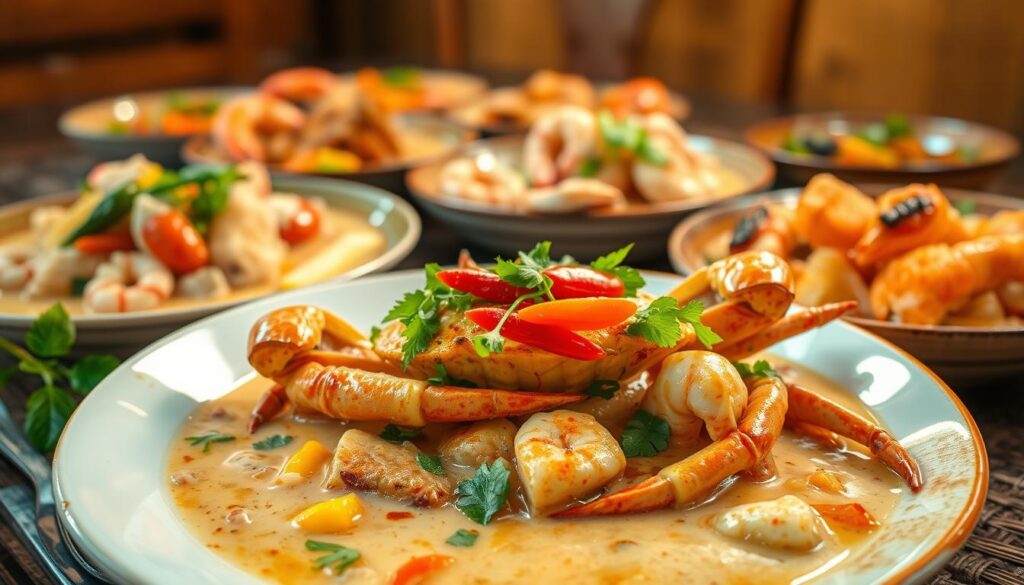
By trying these variations, we keep Ginataang Alimasag alive and evolving. It remains a dish that adapts to changing tastes and preferences over time.
Serving Suggestions and Perfect Pairings
The joy of Ginataang Alimasag comes from how it’s served and paired. It can turn a simple meal into a memorable one.
Traditional Rice Accompaniments
Ginataang Alimasag goes well with steamed rice. This helps soak up the creamy coconut milk sauce. Steamed jasmine rice or garlic fried rice are great choices. For a true Filipino touch, try sinangag (Filipino garlic fried rice).
Complementary Side Dishes
Adding side dishes can make your meal more interesting. Grilled vegetables or a salad with citrus vinaigrette offer a nice contrast. You can also try lumpiang kangkong (water spinach spring rolls) or ensaladang talong (grilled eggplant salad).
Beverage Pairings
For drinks, a glass of iced tea or citrus-infused water can balance the dish’s richness. For a festive touch, a cold beer or a glass of white wine like Sauvignon Blanc pairs well.
Storing and Enjoying Leftovers
When you’ve cooked more Ginataang Alimasag than you can eat at once, it’s key to know how to store leftovers right. This way, you can enjoy it again without losing its taste or safety.
Proper Storage Methods
To store Ginataang Alimasag leftovers, use an airtight container. This keeps moisture and other flavors out. Refrigerate it within two hours of cooking. It can stay fresh for up to 2 days.
- Cool the dish to room temperature before refrigerating.
- Use a shallow container to help it cool faster.
- Label the container with the date.
Best Practices for Reheating Seafood Dishes
Reheating Ginataang Alimasag needs gentle heat to avoid coconut milk curdling. Use low heat and stir often until it’s warm all the way through.
| Reheating Method | Tips |
|---|---|
| Stovetop | Heat on low, stirring occasionally. |
| Microwave | Cover and heat in 30-second increments, stirring between each heating. |
Conclusion
Ginataang Alimasag is a true Filipino culinary delight. It combines crab and coconut in a rich way. This dish shows the country’s love for seafood and creamy coconut milk.
Now, you can make this beloved Filipino dish at home. It has tender crab, aromatic spices, and smooth coconut milk. It’s sure to make your taste buds happy and leave you craving more.
Feel free to try different versions of Ginataang Alimasag. It’s perfect for both experienced cooks and beginners. So, get your ingredients ready, invite friends over, and enjoy the cozy flavors of this traditional Filipino crab and coconut stew.
FAQ
What is Ginataang Alimasag?
Ginataang Alimasag is a traditional Filipino dish. It’s made with crabs cooked in coconut milk. This dish shows the rich culinary heritage of the Philippines.
What type of crabs are best for Ginataang Alimasag?
For the best flavor and texture, use fresh blue crabs or mud crabs. They are the top choice for an authentic Ginataang Alimasag.
Can I use canned coconut milk for Ginataang Alimasag?
Yes, canned coconut milk is a good option. It adds a rich and creamy texture to the dish.
How do I prevent curdled coconut milk in Ginataang Alimasag?
To avoid curdled coconut milk, simmer it gently. Don’t boil it too hard. This ensures a smooth and creamy sauce.
What are some common variations of Ginataang Alimasag?
You can add vegetables like spinach or malunggay for extra nutrition. There are also regional and modern twists to the classic recipe.
How should I store leftovers of Ginataang Alimasag?
Cool the dish to room temperature first. Then, refrigerate or freeze it in airtight containers. Always follow proper food safety guidelines.
What are some traditional accompaniments to serve with Ginataang Alimasag?
Traditionally, serve Ginataang Alimasag with steamed rice. The rice helps soak up the flavorful coconut milk sauce, making it a satisfying meal.
Can I reheat Ginataang Alimasag?
Yes, you can reheat it gently over low heat. Add a splash of coconut milk or water if needed. This keeps the sauce’s consistency and ensures the dish stays flavorful and safe to eat.

